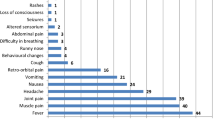Abstract
Purpose
To compare the outcome of pregnancy between HIV positive pregnant women on highly active antiretroviral therapy (HAART) and HIV negative controls.
Methods
A prospective matched case–control study.
Results
HIV positive women were significantly more likely to have anaemia in pregnancy [p < 0.001, odds ratio (95% CI) 5.66 (3.0–10.5)], intrauterine growth restriction [p = 0.002, odds ratio (95%CI) 13.82 (1.8–106.7)], preterm labour [p = 0.03, odds ratio (95% CI) 2.89 (1.2–7.0)] and birth weight less than 2,500 g [p < 0.0001, odds ratio (95% CI) 5.43 (2.4–12.0)]. The 5-min apgar score less than 7, admission into neonatal unit, stillbirth and perinatal mortality were comparable between the two groups.
Conclusion
Anaemia in pregnancy, intrauterine growth restriction, preterm labour and birth weight less than 2,500 g are important complications among HIV positive pregnant women. This information is vital for strategic antenatal care planning to improve obstetric and perinatal outcome in these women.
Similar content being viewed by others
References
Ekouevi DK, Coffie PA, Becquet R et al (2008) Antiretroviral therapy in pregnant women with advanced HIV disease and pregnancy outcomes in Abidjan, Côte d’Ivoire. AIDS 22(14):1815–1820
Moodley J (2008) Trends in management and outcome of pregnancies in HIV-infected women in the UK and Ireland, 1990–2006. BJOG 115:1074–1075
Carr A, Cooper DA (2000) Adverse effects of antiretroviral therapy. Lancet 356:1423–1430
Federal Ministry of Health (FMOH) (2005) National guidelines for the implementation of prevention of mother-to-child transmission (PMTCT) of HIV/AIDS. Federal Ministry of Health and Social Services, Abuja, Nigeria
Federal Ministry of Health (FMOH) (2006) 2005 Sentinel seropositive surveillance report. National/AIDS/STD Control Programme. Federal Ministry of Health and Social Services, Abuja, Nigeria
Center for Disease Control and Prevention. U.S Public Health Service Task Force recommendations for use of antiretroviral drugs in pregnant HIV-1-infected women for maternal health and interventions to reduce perinatal HIV-1 transmission in the United States. MMWR 2002; 51:1-38
Tuomala RE, Shapiro DE, Mofenson LM et al (2002) Antiretroviral therapy during pregnancy and the risk of adverse outcome. N Engl J Med 346:1863–1870
Madeddu G et al (2008) Successful prevention of multidrug resistant HIV mother-to-child transmission with enfuvrtide use in pregnancy. Int J STD AIDS 19(9):644–645
Marti C et al (2007) Obstetric and perinatal complications in HIV infected women. Analysis of a cohort of 167 pregnancies. Acta Obstet Gynecol Scand 86(4):409–415
O’Brien ME et al (2005) Anaemia is an independent predictor of mortality and immunologic progression of disease among women with HIV in Tanzania. J Acquir Immune Defic Syndr 40(2):219–225
Brocklehurst P, French R (1998) The association between maternal HIV infection and perinatal outcome: a systemic review of the literature and meta-analysis. Br J Obstet Gynaecol 105:836–848
Onah HE, Obi SN, Agbata TA, Oguanuo TC (2007) Pregnancy outcome in HIV positive women in Enugu, Nigeria. J Obstet Gynaecol 27(3):271–274
Lionel J (2008) HIV and obstetric complications and fetal outcomes in Vellore, India. Trop Doct 38:144–146
Lepage P, Msellati P, van de Perre P, Hitimana D-G, Dabis F (1992) Characteristics of newborns and HIV-1 infection in Rwanda. AIDS 6:882–883
Nair P, Alger L, Hines S, Seiden S, Hebel R, Johnson JP (1993) Maternal and neonatal characteristics associated with HIV infection in infants of seropositive women. J Acquir Immune Defic Syndr 6:298–302
Dreyfuss ML et al (2003) Determinants of low birth weight among HIV infected women in Tanzania. Am J Clin Nutr 77(5):1337–1338
Conflict of interest statement
None.
Author information
Authors and Affiliations
Corresponding author
Rights and permissions
About this article
Cite this article
Olagbuji, B.N., Ezeanochie, M.C., Ande, A.B. et al. Obstetric and perinatal outcome in HIV positive women receiving HAART in urban Nigeria. Arch Gynecol Obstet 281, 991–994 (2010). https://doi.org/10.1007/s00404-009-1186-x
Received:
Accepted:
Published:
Issue Date:
DOI: https://doi.org/10.1007/s00404-009-1186-x




